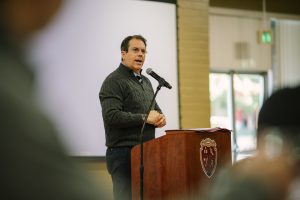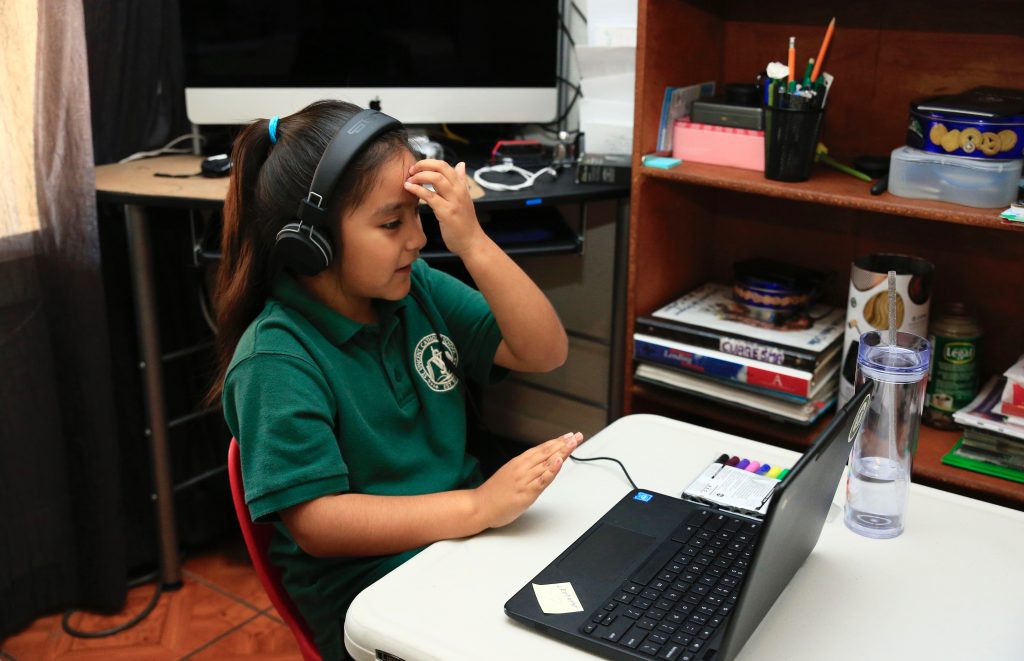When Gary Sullivan met with his fellow faculty members earlier this summer, the list of things to sort out for the upcoming school year was long.
Like other faculty and staff members, Sullivan — the head of the theology department at Damien High School in La Verne — has seen the coronavirus (COVID-19) pandemic cripple school operations. And with health precautions still in place, it was clear from the meeting’s outset that this year at Damien would be unlike any other.
But among the many agenda items, the first one had nothing to do with the technology of distance learning or new scheduling systems.
“Before our faculty talked about logistics, we came together on day one and talked about the Gospels,” Sullivan told Angelus.
After spending an hour with a Scripture meditation, “the logistics and the stress of planning didn’t go away,” Sullivan recalled.
But the time of prayer did help remind the group what their students will be needing most this year.
The COVID-19 pandemic has meant faculty, staff, and administrators at Catholic schools like Damien have had to make tough decisions on how to carry the school year forward.
The time to plan has been slim. Just a few months ago, in June, the Archdiocese of Los Angeles announced that all of its Catholic schools would return to campus this fall in person. But in July, a new state guidance derailed those plans.
“Originally, we had plans to do a hybrid model, where we could do half of the students virtually and half of the students on campus and then just rotate,” Erick Rubalcava, who up until this summer was president of St. Pius X-St. Matthias Academy in Downey, told Angelus.
“With the recent orders that was not feasible, so we’re completely online right now and intend to be so either until there’s a change in the health order or at least for the first quarter, which ends in mid-October.”
Incidentally, Rubalcava is leaving St. Pius X-St. Matthias this month to take over as Assistant Superintendent for High Schools for the Archdiocese of Los Angeles. He and fellow administrators know that this school year could involve bringing students back to school mid-school year, only to send them back to distance learning in the event of another lockdown.
That means that the approach to faith formation — like academic instruction — has to stay flexible this year.
“We are all preoccupied with maintaining the quality of the product and the integrity of the learning process,” Sullivan noted, “while we continue to adapt to our own powerlessness over the decision of when we may return to school [in person].”
The heart of Catholic education
The COVID-19 shutdown last spring saw the moments that Catholic schools are traditionally known for: all-school Masses and penance services, retreats, Stations of the Cross, first Communion and confirmation ceremonies among them, all canceled, postponed indefinitely, or substantially modified in accordance with health regulations.
The pattern is set to continue this fall, depriving Catholic schools of a key ingredient in their daily life.
“Not having the chapel, daily Mass, monthly adoration — a place where students can break away to pray in quiet — or to experience the sacrament of reconciliation will be the most significant deprivation in the area of faith formation,” said Sullivan.
At the same time, the same Catholic faith that thrives from in-person interactions also offers guidance amid physical separation. Marco Roman, who has a doctorate in religious education and is supervisor of High School Religious Instruction and Formation for the archdiocese, sees a common thread running through pre-pandemic times and now.
“When it comes to Catholic education … the same issues apply,” he told Angelus. “It’s just a different context because of the situation we’re in.”

According to Roman, the mission to prioritize faith formation in Catholic schools may be especially relevant now, but it is not new. He pointed to Archbishop José H. Gomez’s five pastoral priorities, the first of which is “education in the faith.”
“Those five pastoral priorities are reflective of the theology curriculum that we also have from the United States Conference of Catholic Bishops (USCCB),” said Roman. “The authenticity of Catholic education has now been a priority in our office for the last couple of years, for sure, and emphasizing that is still an ongoing thing.”
Recalling scriptural passages has proved helpful in maintaining that priority this year. Sullivan described how Damien’s prayer service to kickstart the school year reflected on Christ in the boat with the apostles, sleeping while a storm rages around them.
“We want to enter into that peace,” he said. “That is why our focus this year in theology classes is to bring our students to Jesus Christ, who is the still point around which everything turns.”
From ideas to action
When it comes to continuing faith formation at a distance, “collaboration is key,” Sullivan said. “We, as teachers or as various religions departments, could not do this alone.”
To address this need, Roman’s team set up a webpage where theology teachers can share resources and strategies. Sullivan also has taken advantage of monthly Zoom meetings that were arranged for teachers to exchange ideas and bond with one another.
Meanwhile, Roman has been discussing online resources that support both engaging and accurate religious instruction.
“We’ve had a lot of sessions with the religion teachers … sharing ideas in terms of what’s available out there, in terms of what platforms can deliver the theology curriculum,” he noted.
Even with new ideas and new digital tools, theology teachers and campus ministers will still need to be creative about helping form students in a person-centered faith while unable to meet in person.
“There’s a danger of disincarnation when we can’t meet in person,” said Sullivan. “We use technology to bridge the artificial divide. To be even more personal, more engaging, and more effective, we are asking teachers to see our students every day in Zoom or Google Meet and to communicate more through Remind and Google Stream. Though it’s not perfect, we can converse with them and address each student by name.”
This year, religion teachers will have a host of apps and online platforms at their disposal, such as Loom to record lectures over slide presentations, YouTube videos like the Aquinas 101 series, and prayer apps such as Laudate, Pray As You Go, and Catana.
“Overall, we have found that the sky’s the limit when it comes to accessing great resources online that are faithful to Catholic teaching,” he added.

Ultimately, the goal is to orient students not just toward proper understanding of Catholic teaching but toward Christ himself. This has made strategies to incorporate prayer and reflection into Catholic schools’ remote setup especially important.
“A lot of [schools] have campus ministry teams [that are] trying to prepare online retreats or online days of recollection,” said Roman, stressing the value of these activities for students’ spiritual development.
At Damien, teachers are expected to incorporate prayer in their classes on a daily basis, while videotaped novenas, Stations of the Cross, and a community-wide virtual pilgrimage patterned after the Camino are being planned.
And while the traditional all-school opening Mass was out of the question for St. Pius X-St. Matthias, Rubalcava and his team arranged a “drive-in” parking lot Mass so that families could still gather to pray.
“We’ll try to do that maybe once a month in the evenings for families,” he added. “We’re not a parish school, so we don't have a church, and most of our families might belong to other parishes, so we’ll do additional things to support them.”

Bringing it home
Gathering families for a modified all-school Mass is just one example of faculty and staff trying to extend the reach of faith formation beyond the (virtual) classroom. For Roman, schools’ limited ability to interact with students marks an opportunity to encourage parents to step up in their role as faith instructors.
“It’s a natural opening for us,” he said. “In the faith formation process, this may be an opportune time to include the parents in the more direct way from the schools to assist in the faith formation process … whether it’s participating in the eucharistic liturgy online, evening prayer or prayer during the day, or some kind of discussion regarding theology in the classroom that they’re learning.”
In Rubalcava’s experience, one specific way to engage parents has been through the Augustine Institute’s “Formed” platform, to which his school subscribes. He also has experience on the other end of the equation, as the parent of two daughters attending St. Anthony of Padua School in Gardena, their family parish, which he also attended growing up.
As a parent, Rubalcava has appreciated how the school has likewise shown commitment to supporting families’ spiritual bonds throughout the pandemic. This includes keeping up weekly all-school Masses online, which the whole family can join together. “Keeping that connection, I think, as a family of faith in the parish, for our parish families, is important,” he noted.
Going forward, Sullivan hopes “people will rediscover the true meaning of Catholic education as the gold standard.” Once students can return to their Catholic school campuses, he added, they “will be filled with a new sense of gratitude for being able to see, hear, touch, and taste the beauty, truth, and goodness of the curriculum in real life through incarnational learning.”
Such an image leaves Catholic schools a lot to work toward in the meantime, and a lot to look forward to.

